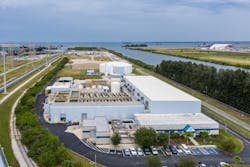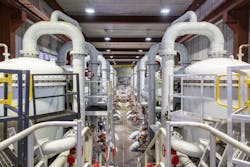Carol Brzozowski is a freelance writer for WWD. Brzozowski can be reached at [email protected].
|
Location: Tampa Bay, Florida Size: 25 mgd Equipment: Reverse osmosis, coagulation, flocculation, sand filters, diatomaceous earth filters, feed pumps, cartridge filters, high-pressure pumps, 48-inch concentrate discharge pipeline |
The importance of a desalination plant cannot be understated in locales such as the Florida peninsula. The Tampa Bay Seawater Desalination facility is a drought-proof, alternative water supply providing up to 25 million gallons per day (mgd) of drinking water to more than 2.5 million people in the Tampa Bay region.
The plant is located in Apollo Beach, Florida next to Tampa Electric’s (TECO) Big Bend Power Station, which withdraws and discharges up to 1.4 billion gallons a day of seawater from Tampa Bay for use as cooling water for the power plant.
The Tampa Bay Seawater Desalination plant captures up to 44 mgd of that warm seawater, separates it into drinking water and concentrated seawater, and dilutes the twice-as-salty seawater before returning it to the bay.
The plant can produce up to 25 mgd and is currently operating at 16 to 20 mgd during the Tampa Bay region’s dry times of the year when less river water is available, notes spokesperson Brandon Moore.
Facility History & Treatment Process
The plant became fully operational in 2007 and cost $158 million to construct, $85 million of which was co-funded by the Southwest Florida Water Management District. Tampa Bay Water owns the facility, which is operated under public-private partnership by the joint venture of American Water and Acciona Agua.
“Before the reverse osmosis (RO) process, seawater entering the desalination plant flows through screens that remove debris, then goes through a traditional coagulation and flocculation treatment process,” Moore said. “In this process, chemicals are added to the seawater to make algae. Organic materials and particles clump together so they can be removed more easily in the sand filtration stage.”
After sand filtration, the salty water goes through diatomaceous earth filters to remove silt and fine particles. Cartridge filters just before the RO membranes serve as a backstop, removing any particles that may be remaining after the diatomaceous earth filters.
“Next is the RO process,” Moore said. “High pressure forces the pretreated water through semi-permeable membranes to separate the freshwater, leaving twice-as-salty seawater and other minerals behind.”
Following the RO process, chemicals are added to stabilize the desalinated seawater. The high-quality water is delivered to Tampa Bay Water’s regional facilities site where it is blended with treated drinking water from other supply sources before being delivered to Tampa Bay Water’s members.
Where Does Reject Water Go?
“At full capacity, the RO process leaves about 19 mgd of twice-as-salty seawater behind, which is returned to Big Bend’s cooling water stream and blended with up to 1.4 billion gallons of cooling water, achieving a blending ratio of up to 70:1,” Moore added. “At this point before entering and mixing with any bay water, the salinity is already only 1.0 to 1.5% higher, on average, than water from Tampa Bay. This slight increase falls within Tampa Bay’s normal, seasonal fluctuations in salinity.”
The cooling water mixture moves through a discharge canal, blending with more seawater and diluting the discharge even further. Tampa Bay Water’s comprehensive hydrobiological monitoring program collects thousands of samples, including continuous salinity measurements every 15 minutes near the desalination facility.
Tampa Bay Water’s Future Plans
Before the end of 2022, Tampa Bay Water will select new water supply projects to serve the region in the near future.
The utility’s 2018 Long-term Master Water Plan Update showed the region will need approximately 10 mgd of new water by 2028 and an additional 10 mgd by 2038. As part of that planning effort, three projects were approved for further evaluation:
- Expand surface water treatment capacity at either the existing treatment plant or at a new facility co-located with the C.W. Bill Young Regional Reservoir to treat additional water from the Tampa Bypass Canal, Alafia River or regional reservoir.
- Expand the existing desalination plant to treat additional seawater; and
- Establish new groundwater via aquifer recharge credits.
Tampa Bay Water will present project configuration options to its board of directors beginning in May and will present ranked configurations in late summer.



